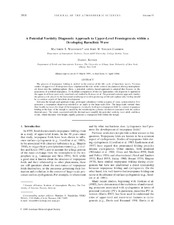| dc.creator | Wandishin, Matthew | |
| dc.creator | Nielsen-Gammon, John | |
| dc.creator | Keyser, Daniel | |
| dc.date.accessioned | 2016-10-28T18:59:25Z | |
| dc.date.available | 2016-10-28T18:59:25Z | |
| dc.date.issued | 2000-12-15 | |
| dc.identifier.citation | Wandishin, M. S., J. W. Nielsen-Gammon, and D. Keyser, 2000: A potential vorticity diagnostic approach to upper-level frontogenesis within a developing baroclinic wave. J. Atmos. Sci., 57, 3918-3938. | en |
| dc.identifier.uri | https://hdl.handle.net/1969.1/158223 | |
| dc.description | © Copyright 2000 American Meteorological Society (AMS). Permission to use figures, tables, and brief excerpts from this work in scientific and educational works is hereby granted provided that the source is acknowledged. Any use of material in this work that is determined to be “fair use” under Section 107 of the U.S. Copyright Act September 2010 Page 2 or that satisfies the conditions specified in Section 108 of the U.S. Copyright Act (17 USC §108, as revised by P.L. 94-553) does not require the AMS’s permission. Republication, systematic reproduction, posting in electronic form, such as on a web site or in a searchable database, or other uses of this material, except as exempted by the above statement, requires written permission or a license from the AMS. Additional details are provided in the AMS Copyright Policy, available on the AMS Web site located at (https://www.ametsoc.org/) or from the AMS at 617-227-2425 or copyrights@ametsoc.org. | en |
| dc.description.abstract | The process of tropopause folding is studied in the context of the life cycle of baroclinic waves. Previous studies of upper-level frontogenesis have emphasized the role of the vertical circulation in driving stratospheric air down into the midtroposphere. Here, a potential vorticity–based approach is adopted that focuses on the generation of a folded tropopause. To facilitate comparison of the two approaches, the diagnosis is applied to the upper-level front previously simulated and studied by Rotunno et al. The potential vorticity approach clarifies the primary role played by the horizontal nondivergent wind in producing a fold and explains why folding should be a common aspect of baroclinic development.
Between the trough and upstream ridge, prolonged subsidence within a region of weak system-relative flow generates a tropopause depression oriented at an angle to the large-scale flow. The large-scale vertical shear then locally increases the slope of the tropopause, eventually leading to a tropopause fold. In contrast, tropopause folding in the base of the trough is caused by the nondivergent cyclonic circulation associated with the surface thermal wave. The winds associated with the thermal wave amplify the potential vorticity wave aloft, and these winds, which decrease with height, rapidly generate a tropopause fold within the trough. | en |
| dc.description.sponsorship | National Science Foundation | en |
| dc.language.iso | en_US | |
| dc.publisher | American Meteorological Society | |
| dc.subject | tropopause folding | en |
| dc.subject | stratosphere-troposphere exchange | en |
| dc.title | A Potential Vorticity Diagnostic Approach to Upper-Level Frontogenesis within a Developing Baroclinic Wave | en |
| dc.type | Article | en |
| local.department | Atmospheric Sciences | en |
| dc.identifier.doi | 10.1175/1520-0469(2001)058<3918:APVDAT>2.0.CO;2 | |


